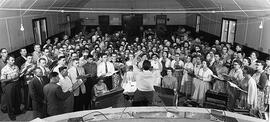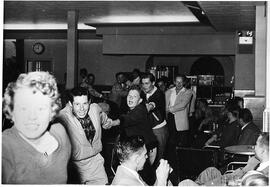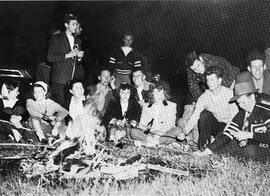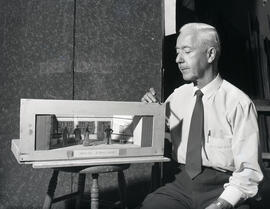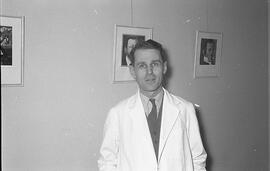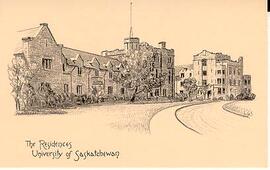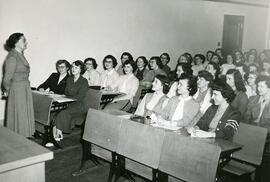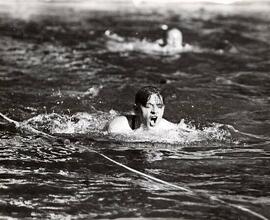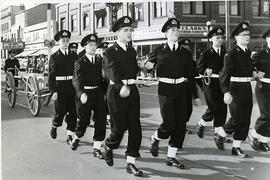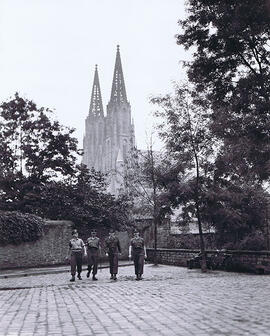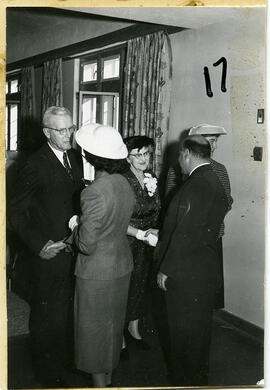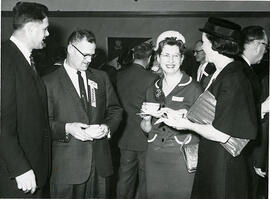Head and shoulders image of Dr. Eric M. Nanson, Professor and Head, Department of Surgery, University Hospital, 1954-1969.
Bio/Historical Note: Dr. Eric Musard Nanson was born 4 January 1915 in Geraldine, South Canterbury, New Zealand, and took his early education in Christchurch. He was awarded the University National Scholarship of New Zealand in 1934 and in that year went to Canterbury University College before proceeding to Otago University in Dunedin the following year for medical studies. In 1937 he was awarded the senior university scholarship of New Zealand and he qualified in 1939. Dr. Nanson’s early appointment was as house surgeon at Christchurch Hospital from 1939-1941. During part of this time he also served as demonstrator in anatomy in the University of Otago. Dr. Nanson then joined the New Zealand Medical Corps as a captain from 1941-1945, serving with the second New Zealand Expeditionary Force in the Middle East, North Africa and Italy as Officer Commanding an ambulance train and medical officer in both a field ambulance and a base hospital. After demobilisation in 1945 he was initially surgical registrar at Waikato Hospital, Hamilton, and later surgeon superintendent at Buller Hospital, Westport before deciding to come to England. Within a few months of arriving he had passed the FRCS and was surgical registrar at St. James' Hospital, Balham, and later assistant in the surgical professorial unit at St. Bartholomew's Hospital. Dr. Nanson spent a year as senior surgical registrar at St Peter's Hospital, Henrietta Street, before going to work as Rockefeller Foundation Fellow in the department of surgery at Johns Hopkins Hospital, Baltimore, for nine months. He returned to England in 1951 and worked in Bristol as lecturer in surgery at the university for just over a year before being invited to return to Johns Hopkins as Associate Professor of Surgery. Dr. Nanson was elected Hunterian Professor on two occasions. In 1954 he was appointed as the Foundation Professor of Surgery at the University of Saskatchewan and served as consultant surgeon to City Hospital, St. Paul's Hospital and Saskatoon Sanatorium. He remained in this post for fifteen years and played an important role in the development of the undergraduate medical curriculum. Dr. Nanson also pursued a policy of continuing medical education and postgraduate education which enabled Saskatchewan to rely on its own graduates rather than immigrant doctors from other provinces and countries. Dr. Nanson was elected a Fellow of the Royal College of Surgeons of Canada in 1954 and of the American College of Surgeons in 1956. In 1970 he was appointed Foundation Professor of Surgery in the School of Medicine at the University of Auckland and held this post for ten years. His enthusiasm persisted and in addition to introducing the concept of a trainee internship to the department of surgery, he was co-author of the Handbook for Clinical Students which is a constant companion to undergraduate medical students. Dr. Nanson continued to perform administrative duties in addition to his clinical and teaching commitments. He carried out a prodigious amount of research work throughout his life which was published in over 100 papers in Canadian, British, American and New Zealand journals. These covered a wide range of subjects and reflected his extensive knowledge and experience in surgery. After retiring in 1979 from the Chair of Surgery at Auckland, he was awarded the Ordinary Officers of the Civil Division of the Most Excellent Order of the British Empire (OBE) award. His interest in academic work was such that after retiring from clinical work he taught anatomy at the Auckland Medical School. His enthusiasm for clinical work persisted and he continued to attend surgical meetings until shortly before his death. Dr. Nanson died 27 September 1988 in Auckland.



